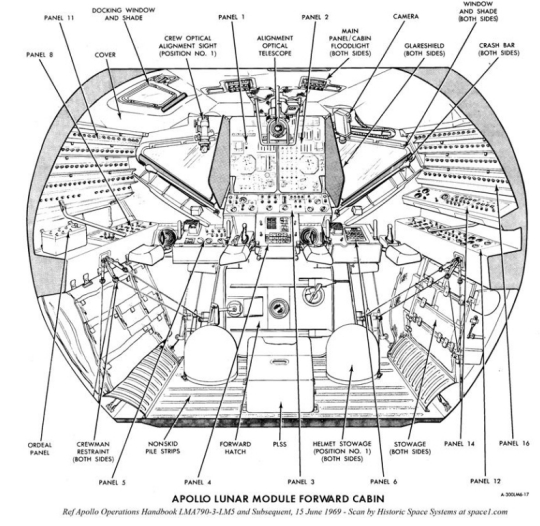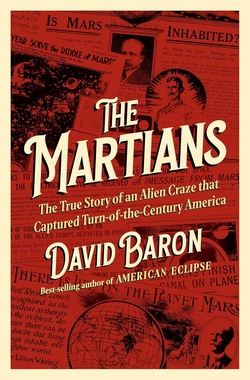Centauri Dreams
Imagining and Planning Interstellar Exploration
From the Moon to the Stars
I’ll close my coverage of the Apollo 11 anniversary with thoughts from Marc Millis. I was startled to discover, fifty years after watching the first landing on the Moon, that the anniversary seemed almost elegiac. So many expectations that have yet to emerge, so much energy still waiting to find an Apollo-like focus. Marc has likewise been ruminating on the Moon landings and here offers a way of placing them in context. Such an effort invariably means invoking the long view, one I found challenging to sustain because of my own freighted memories of 20 July, 1969.
But I think Marc is right in looking for longer, more stable arcs of development and trends that the rush of daily activity can obscure. The former head of NASA’s Breakthrough Propulsion Physics project, Millis is also editor (with Eric Davis) of the book Frontiers of Propulsion Science (2009) and the founder of the Tau Zero Foundation. He has been developing an interstellar propulsion study from a NASA grant and recently returned from Europe, where he worked with Martin Tajmar’s SpaceDrive project at Germany’s Technische Universität Dresden.
by Marc G Millis

Anniversaries have a way of making us reflect. I was 9 years old during the first Moon walk. That event, and the steady progress that preceded it, profoundly affected me. Its power was more than just the amazing new technology and the mind-blowing fact that humanity was no longer constrained to this planet. I was also struck by how it affected the world.
For days following of the landing, the world was one. We were human beings sharing an amazing, peaceful, intellectual, human achievement. This achievement interrupted the usual gloomy news of war, social injustice, and the specter of imminent nuclear destruction. It showed us a side of humanity that made us feel good and cast hope for a better future. After centuries of humanity’s dreams about the Moon, we did it.
I broke out in tears when I recently heard the replay of the transmission: “Tranquility Base here. The Eagle has landed.” I recall, in that moment, how the future of humanity changed. All the way up to that point, we were not sure if touching the Moon was just fanciful wishing. After that point, it was fact. We knew, then, that humanity could accomplish great things – when we set our sights toward doing great things.
Instead of revisiting the real motivations for Apollo, I want to share the effect it had on an impressionable child. From my naive and idealistic 9-year-old view, I assumed that our national leaders had deliberately designed the Space Program as a catalyst for a sustainable modern Renaissance. I saw the Space Program as the grand challenge that would drive technological progress, extend prosperity and improve humanity. It gave the citizens a future they could look forward to. It gave us frontiers to conquer rather than the alternative of conquering each other.
On the individual level, it gave students a reason to excel in their studies and the prospect of meaningful careers – reasons to avoid drugs and debauchery. It made so much sense; healthy, exciting and positive. And the fact that the Moon landing was done as promised and on schedule – that fact made our national leaders look competent and trustworthy. Impressive stuff.
A year prior to the Moon landing, the movie 2001 a Space Odyssey showed us a vision of such a future. It included commercial shuttles taking passengers to an orbiting space station – complete with hotels and passport control. Moon bases not only existed, but there were several of them. The producers hired suitable aerospace professionals as consultants so that all of these things were envisioned plausibly – and it worked.
The dramatic contrast between the silence of space and the sound of breathing inside a spacesuit is etched in my memory. The portrayal of the difference between microgravity and artificial gravity (and vacuum and air) was convincing. The characters behaved in a manner consistent with their roles. The total effect is that 2001 cast an image of what the future could be, and based on the pace of the 60s Space Program, I expected it was the future that would be.
Fast-forward to now. Despite the painful demotion of the Space Race after Apollo into something more like a subdued slog, progress accumulated. A half century since Apollo, thirteen nations (or groups thereof) have space programs, including a few rich guys with their own launchers. Over 4600 spacecraft are in Earth orbit and about 150 farther beyond. Our satellites have saved countless lives with hurricane warnings, are keeping an eye on the health of our environment, and have enabled a level of world connectedness through communication that I hope fosters sustainable peace. We’ve seen planets and moons as never before. We’ve listened to the winds on Titan. And the tally of strange new worlds (exoplanets around other stars) has surpassed 4,000. One thing we still don’t know is if there is life beyond Earth.
Eclipsing nationalistic survival (and curiosity), the most common motive driving space development is now profit, where more than ¾ of space activities are commercial. Financial institutions have taken notice, seeing a market of $350 billion and growing. Bank of America Merrill Lynch sees the space industry reaching $2.7 trillion in 30 years. Combinations of government agencies and businesses – some collaborating, some competing – are embarking on Moon outposts with Mars as the sequel, plus the infrastructure to keep it all growing.
The scale of activity envisioned in 2001 might actually come to pass, but perhaps closer to 2041. It’s no longer a matter of “if it can be done,” but “when will it be fiscally prudent.” The age of rocket science, which was once just science fiction, has given way to engineering and business.
In the 1960s, when Moon missions were becoming reality, fiction about practical starflight emerged from science fiction magazines and novels into television and movies seen worldwide. Compiling ideas from decades before, Gene Roddenberry’s Star Trek put it all together in a positive future vision, where the incredible power of starships would be used by a responsibly mature society, where minorities and people from various cultures were included. In that future, you could explore strange new worlds, seek out new life and new civilizations. And once finding a new civilization, you could magically fix its silly social injustices in just a one-hour episode, while having time for romances with aliens. Inspiring stuff.
Moon missions were once derided as unrealistic fantasies at a time when the hot activity was advancing the emerging aircraft industry amidst two world wars. Of course, this does not mean that all science fiction will become real, but it does means that many of tomorrow’s realities appear impossible today. We just don’t know which of these are genuinely impossible and which suggest nothing more than an absence of imagination. This also means that pioneering work typically starts small, as minority efforts amid preoccupation with the era’s dominant activities.
Looking back to what made Apollo possible – that transition point when rocketry matured from art and fiction to become a science — that point was reached when Russian mathematician Konstantin Tsiolkovsky derived the “rocket equation.” Following its math, the scale of the challenge could be conceptualized and achieved. Coincidentally, this was the same year the Wright Brothers flew the first functional aircraft. In 1903, rocketry became a science, and air flight became engineering. A mere 66 years later, rocket science matured to engineering, and humans walked on the Moon. And now a half-century after the landing, spaceflight engineering has matured to business, and is on the verge of being available for recreation.

Image: Konstantin Tsiolkovsky, Russian pioneer in aeronautics and astronautics. Credit: Wikimedia Commons.
It is tempting to view interstellar pursuits in the same paradigm as the modern space industry, a sequence of expected and profitable next steps. While there is certainly some fertile ground in that notion, the complete challenge of practical starflight is at a much earlier stage, where it still benefits from thought-provoking science fiction and the pioneering science that precedes what can be engineered.
About three decades after Star Trek debuted, the fiction of faster-than-light (FTL) flight entered the sciences the same way rocketry did – with equations that revealed the scale of the challenge. Specifically, this fleshing out of the mathematics includes Morris-Thorne traversable wormholes (1988) and the Alcubierre warp drive (1994). Then came NASA’s Breakthrough Propulsion Physics project in 1995, which lasted until 2007 (though funding ended in 2002).
Instead of advancing technology within the limits of known physics, the NASA project sought further discoveries in physics to lay the foundations for new, breakthrough technologies. This inquiry encompassed the possibilities of FTL, non-rocket spacedrives, control of gravitation, and other related ambitions. A comparison of these ambitions to the lingering unknowns in physics was compiled in the 2009 book Frontiers of Propulsion Science. Its intent was to identify which research questions are attackable and relevant to these grander goals, showing the incremental steps that could begin today to chip away at the long string of unknowns.
Will the fiction of practical starflight eventually become reality? If I were clairvoyant, I could answer that question, but I’m not. What I do know is that, even if such ambitions turn out to be impossible, we will gain more in the attempt than by waxing pedantic or only working on what’s financially profitable.
It is my hope that progress will continue along all these fronts and improve the human condition. The next steps toward the Moon, Mars and recreational spaceflight will usher in a new era, a suitable name for which will probably be conceived years later. It’s certainly no longer a “space race” with only one finish line. It is the beginning of a new stage of humanity.
I also hope, amidst this ongoing activity, that we remember to support pioneering attempts to learn how to protect Earth’s habitability and take us to the stars even if they are not in the short run economically profitable.. And lastly, I hope that all these things will usher in a new Renaissance, if not by design, then by consequence, where the best aspects of the human character prevail to make our future not only sustainable, but also deeply exciting.
One closing thought. Idealism is one thing, but we must also consider the reality of human character. Progress in the 1960s was fueled by fear for survival and the urge to retain power, the most powerful motivations on the Maslow hierarchy of needs. The advances made while extinguishing those fears have now made it possible for people to personally profit from space, and even flaunt their status. In addition to commercial satellites, we’ve got rich guys creating their own space programs with a bit of “my rocket is bigger than your rocket” bravado.
I must confess that I thoroughly enjoy the swagger of throwing one’s shiny red sports car into space. Wherever humanity travels in the future, we will bring all of our human character with us, the good and the bad. It is my idealistic hope that, amid the self-serving motives that are fueling our current space age, we may also learn how to mobilize for the greater good.

Neil Armstrong: 2011 Speech in Australia
If a connection between accounting and astronautics seems tenuous, it’s one that Neil Armstrong invoked on the 24th of August, 2011, when he spoke before CPA Australia in Sydney, doubtless motivated by his father’s career as an auditor. Armstrong stopped signing autographs in 1996 and rarely spoke in public, but accepted the Sydney invitation, according to members of the audience, because of his declared ‘soft spot’ for accounting. While no video was allowed during the speech, author Neil McAleer has had access to an audio recording, though one of uneven quality. What follows is an excerpt from a longer project on the Moon landing that McAleer is working on, within which he adds commentary to the parts of the speech he was able to transcribe. Armstrong’s words throughout are in quotes, with McAleer’s additions in standard text. The first man on the Moon would die almost exactly one year after giving this speech.
“I am truly delighted to be here today and I thank you for the wonderful offer. And I thank the CPA for giving me an opportunity to play a part in this 125 anniversary gathering of your industry. . . .
“You might ask me, ‘how does it feel to be the oldest person in the room?’ [laughter] “Well, I ‘m not thrilled about it, but I am encouraged by old timers who did great things as senior citizens.
“Galileo invented one of his greatest discoveries at the age of 73. Edison was still inventing in his 80s. Toscanini was still conducting at 87. Titian, the famous Italian artist, painted the great battle of Lepanto at the age of 85.
“So, if there’s a need to find someone to command a starship for a tour around the Solar System, I am available. [Laughter and Applause]
“And if there’s anyone here tonight who is more senior than me, I apologize and congratulate you!”

Image: Neil Armstrong speaking in Australia. Credit: Alan Kerlin.
Armstrong next talked about his father Stephen’s vocation, employed by the state of Ohio “to audit the books of its various county governments.” It involved a great deal of travel throughout the state.
“As a consequence of his job, he encountered the occasional embezzler, and eventually acquired the nickname of ‘Suicide Steve’.
“My father was a numbers guy and took great pride in his mastery of numerical precision. I shared this aptitude and affection for mathematics, which strongly influenced my educational career track toward engineering. Both careers are highly dependent on precision mathematics.”
An aptitude for math was certainly useful for a young boy who got his pilot’s license at age 16, who ultimately went on to serve as a fighter pilot in the Korean War, then a test pilot at Edwards Air Force Base, and then astronaut and commander of the first landing on the Moon—Apollo 11.
But throughout his life, Armstrong would always emphasize a personality trait that he believed was even more important than the technical skills needed in various professions. He quoted Calvin Coolidge.
“‘Nothing in this world can take the place of persistence: Talent will not; . . . Genius will not; . . . Education will not . . . Persistence and determination alone are omnipotent. Think about actress Elizabeth Taylor, for example. She was highly determined over many years in her search for the perfect husband.”
Neil’s next anecdote was a brief summary of a crisis between an accountant and his wife.
“A chief financial officer . . . is meeting with his accounting team for the purpose of finalizing and releasing their annual financial report. It is scheduled for a Saturday morning. The accountant’s wife has planned a special family luncheon to meet their daughter’s fiancé and his parents for a celebratory and get-acquainted lunch. ‘You must be home by 1:00 o’clock,’ ” his wife insisted.
“Well, what often happens, the annual meeting went on all morning and into the afternoon—the schedule had suffered because of some urgent issues that had to be addressed and resolved. The accountant got home very late —not just a little bit but a lot. The luncheon was long over and the guests had already left.
“His wife was more than distraught. She was crying! ‘I just can’t believe you,’ she sobbed. ‘You love accountants more than you love me!’
“The accountant didn’t know how to respond, but finally he replied: ‘I love you more than I love lawyers!'”
A story about domestic strife between an accountant and his wife moves to Armstrong’s thoughts of risk.
“Risk is a part of all our lives. There is no planned spaceflight mission that doesn’t carry potential risk. There is little progress without risk. In spaceflight we are genuinely dealing with the realities of risk. And increasingly today the popular business management curriculum has adopted risk management courses.
“Take as an example choosing the trajectory to travel from earth to the Moon . . . NASA selected a very particular route called ‘the free return trajectory.’ . . .”
This trajectory is one of the many decisions /actions taken by NASA to protect all its Apollo missions to the Moon from disaster, including the survival of the crippled Apollo 13 mission and the return of the crew safely to Earth. It was probably the most important safety feature of the entire Apollo Moon program—a pre-planned backup, save-the-mission strategy.
Although it never happened during an Apollo mission, if the programmed rockets didn’t fire or fired in error for the lunar orbit insertion maneuver (which had to succeed for a Moon-landing mission), the free return trajectory would use just the right amount of the Moon’s gravity to return the Apollo spacecraft safely to earth —avoiding an otherwise eternal voyage into the cosmos.
It is important to note that the explosion of the oxygen tank in the command module Odyssey (Apollo 13) occurred during one of the most benign parts of the mission as compared to the lunar orbit insertion rocket ignition. Had it happened then, or at other crucial times in the flight, the outcome could have been the loss of the spaceship and crew.
In reality, however, the crippled Apollo 13 spacecraft still needed a trajectory correction because of the impact of the oxygen tank explosion and other factors. This would insure the gravity of the Moon would successfully and accurately execute the free return trajectory. How would the maneuver be made? The creative answer from the crew and NASA experts back on earth was to use the fuel and engine of the undamaged (and unused!) Lunar Module, Aquarius, to correct the free return trajectory. This was the crew’s survival ticket back to earth.
Many people asked why NASA named their ill-fated April 1970 mission Apollo 13, said Armstrong. “After all, the number 13 is considered an unlucky number in much of the world. NASA answered that as an agency they are not superstitious but scientific and rational in all their program decisions.
“Nevertheless, NASA still says they are scientific, but they never did use the number 13 again to designate another spacecraft mission.” [Laughter]
Associated with the risk in our daily lives is the phrase ‘better than,’ and the common human motivation to lower risk and stress, raise our goals, and live a better, more productive and happy life. Armstrong spoke to his ‘down under’ audience about this.
“We are all trying to be better than last year. Every sports team wants to be better than other teams in the league–better than our competition. Our young President Kennedy didn’t just want to catch up with the Russians; he wanted us to be better than the Russians. That was the beginning of the space race to the Moon. ‘Better than’ is an important part of our lives—the essence of competition, the essence of progress.”
About this time in Armstrong’s speech, he returns to the flight of Apollo 11, and describes leaving our home planet for the first time. The crew is in orbit above the Earth, waiting for the engine burn that will take them to escape velocity, deliver them to the Moon and change human history. He tells a personal story, at times including dramatic imagery, starting with the ignition of the 3rd stage engine of the Saturn V, which will send them “more than 10 times the speed of a flying bullet” toward their destination.
“If you increase your speed from your orbital velocity by just 41%, you will reach escape velocity,” and without other thrust corrections (most critically the lunar orbit insertion) you could be ‘lost in space,’ forever. “In our business it’s a handy fact to keep around.” [Laughter]
“Imagine you are in your spacecraft in orbit around the earth [on the nightside] and you are looking down at a few lights on Ascension Island in the South Atlantic, some 1,600 kilometers off the coast of Africa, where lightning storms are active and illuminating thunderheads. You also see village lights and a few shooting stars.
“You must soon ignite the 3rd stage engine of your Saturn V, at a very precise time—within a fraction of a second. You enter some data into the computer which arms the rocket engine. Ignition occurs over the Indian Ocean. You feel the engine come to life; you feel the strong push of gravity in your back. You’re moving outward from earth.
“In earth orbit you were going 27,362 kilometers per hour and now you are in the process of increasing your speed by 11,493.3 kilometers per hour to reach escape velocity.
“You are still on the nightside of earth. In the dark you just can’t see anything–no visual confirmation. Soon you see a sliver of light marking the dawn—a flight back into sunlight. The engine stops; you are floating again. You’re moving outward from earth, but you seem to be motionless. In a half minute you are flooded with sunlight.
“The countries of earth are dropping away from you— you see Malaysia and Indonesia below, Australia off to the right, Japan off to the left. The horizon is growing. All of a sudden you can see the entire circle of old planet earth.
“A gigantic blue medicine ball, covered with white lacy clouds, is exploding slowly away from you into the vacant black sky [out the window above].
“This is the time you say to yourself, “Ah oh!—Maybe you should have taken the CPA route in life.” [audience laughter]
The long voyage to the Moon is now ahead for the Apollo 11 crew. Sometimes it feels like there’s just too much conversation from the ground controllers.
“Every couple of minutes we’d hear, ‘Hello Apollo, this is Houston’ or ‘Hello 11, this is Houston’.
“I don’t know why they say that. Who else is in the area?
“It was nice to hear their voices, of course, and hearing their expert advice, which was available when we needed it. It was teamwork, cooperation. All of you know about teamwork. It is essential for all of us.”
Armstrong’s speech then flashed back to June 1969, a few weeks before the launch of Apollo 11. He was setting the scene for his out-of-the world narrative and the climax to his story of Apollo 11, when its engine was silent and Eagle touched down on the Moon’s surface.
“A month before the launch of Apollo 11, we decided we were confident enough we could try an attempt on a descent to the surface,” said Armstrong. “I thought we had a 90% chance of getting back safely to Earth on that flight but only a 50-50 chance of making a landing on that first attempt. There are so many unknowns on that descent from lunar orbit down to the surface that had not been demonstrated yet by testing and there was a big chance that there was something in there we didn’t understand properly and we had to abort and come back to Earth without landing.”
As Armstrong and Aldrin descended to the surface in the Lunar Module Eagle, their on-board computer was indicating they would land on the side of a large crater, with steep slopes and large boulders that would put them at serious risk.
“Not a good place to land at all,” Neil said. “I took it over manually and flew it like a helicopter out to the west direction, took it to a smoother area without so many rocks and found a level area and was able to get it down there before we ran out of fuel. There was something like 20 seconds of fuel left.”
It was now time for Armstrong to present the denouement of his, and the world’s, Moon drama, from the perspective of 42 years, to his Australian audience, which included an enthusiastic group of still active Aussie ‘space cadets’ who had tracked and gathered, and passed on data to Houston during the mission in July 1969, and the other Apollo missions to follow.
His story would be enhanced with 21st century technical breakthroughs. The most dramatic was a robotic spacecraft named the Lunar Reconnaissance Orbiter (LRO), launched to orbit the Moon in June 2008 and carrying the latest advances in space imagery. The high-resolution cameras focused on visually mapping the entire surface of the Moon, with the exception of shadow areas always in darkness. And naturally, the landing sites of all Apollo missions would merit special emphasis and scrutiny. Google Moon would also provide its expertise in map-making and scanning techniques integrated with LRO’s superb data. Google’s images were oblique, not vertical like those produced by LRO.
All this 21st century technology would feature in the last minutes of Armstrong’s discussion of the Eagle landing on the Moon. And Neil’s audience would be the first to see it—after a group of experts processed and juxtaposed 1969 and 2011 images for a one-of-a-kind video.
“I became aware of this remarkable video imagery because of an Australian friend,” Armstrong said, “and the original alumni Australian tracking team who participated in the early tracking Apollo missions work in the 1960s. They have been working hard to upgrade the data and imagery captured from the Moon landing. This has become a valuable interpretation of this [early] space age material.”
Later, toward the end of his speech, Armstrong took the time to recognize and thank all those original alumni of the tracking team who were in the audience.
“No one has ever seen what you are going to see tonight. Getting this short new video allows me to again see the landing approach [with new technology]. A short 3 minute film clip available for your premier showing– and it might not work at all!
“In the left screen you will see the 1969 film from the Eagle’s cockpit, looking out the window. Compare craters in the left images of 42 years ago, with the right view taken in the last few years. In the background [1969 audio] the crew is talking, and also mission control. The computer tells us it’s taking us down to a landing just on the right side of that big crater, certainly not a place I would like to land.”
https://www.youtube.com/watch?v=tM3Bx6Mt8Dg
[PG: The video above is the closest I can come to what Armstrong would have used in Australia.]
Armstrong narrates the action in the enhanced video: “Everything looks good. It’s a go, says mission control at 100 meters above the surface. I’m looking down in this 30- meter crater below–looking for a smooth area away from this crater with large boulders. [He has less than 2 minutes of fuel left at this point.] Fifty meters above the surface—still looking good. Engine is starting to kick up some dust from the surface on left view. There you see the shadow of my landing leg coming down on the surface. We are very close to the surface right now.” [The famous soundtrack from 1969 is heard.]
Aldrin: Okay – engine stop.
Mission Control: We copy you down, Eagle.
Armstrong: Tranquility Base here – the Eagle has landed. [A crescendo of applause from the audience]
“With this picture on the right, you see the landing stage—from LRO imagery, a vertical shot of our landing spot – you see the landing part of Eagle -what was also the launch pad for the return to Moon orbit and rendezvous with Columbia.
“And 2 years ago [in 2009] NASA approved and began the restoration of the hard drives from the lunar landings—with the substantial involvement of the tracking station experts in Australia” [and elsewhere].
“Our understanding of the Moon, our nearest cosmic neighbor, has multiplied a thousand fold after the flights of Apollo in the 1960s and early 1970s.

Image: This photograph of astronaut Neil A. Armstrong, Apollo 11 commander, was taken inside the Lunar Module (LM) while the LM rested on the lunar surface. Astronauts Armstrong and Edwin E. Aldrin Jr., lunar module pilot, had already completed their historic extravehicular activity (EVA) when this picture was made. Astronaut Michael Collins, command module pilot, remained with the Command and Service Modules (CSM) in lunar orbit while Armstrong and Aldrin explored the Moon’s surface. Credit: NASA.
“We believe our goal was a worthy goal. Connected with our two-word phrase ‘better than’ – the first tenet is quality and that applies to this 21 century, when we can be exceeding the results of the 20th century. Above all else is the quality of the people-in any organization the quality of its people is paramount. There is nothing more important than the quality of your teammates.
“Another tenet of ‘better than’ is leadership . . . The effective leader must be able to adapt to changing conditions.
“Sixty-seven years ago, during the second Great War, a flyer disappeared in his P-38 reconnaissance plane over the Mediterranean. The flyer was better known for his writing than his flying. He was the author of The Little Prince, Wind, Sand and Stars, and Night Flight. His name was Antoine de Saint-Exupery. A definition of leadership was captured in his novel, The Wisdom of the Sands:
“‘If you want to build a ship, don’t drum up the men to gather wood, divide the work, and give orders. Instead teach them to yearn for the vast and endless sea.’
“I was fortunate enough to be led by men who made me yearn for the vast and endless sea above the surface of the earth, and I am in their debt, and I am in your debt for allowing me to be with you today and for giving me a most valuable gift—your time. And I thank you very much.”
End of August 24, 2011 Speech in Sydney, Australia.
Over time Neil Armstrong evolved his speaking techniques and used more humor in his presentations, sometimes doing vocal imitations of the characters in his stories. Several times he imitated a Scottish accent—once when he was accepting an award in Edinburgh, Scotland.
In another story that fellow astronaut Jim Lovell enjoyed telling, Armstrong told the tale of two experimental mice who were in the final countdown to the launch of their suborbital flight. They were flying in a salvaged WWII V-2 rocket at the White Sands Rocket Range in New Mexico during the early days of life-in-space studies. Armstrong mimicked the high-pitched voices of the mice astronauts, strapped to their cockpit chairs and discussing the life-threatening dangers (explosions, parachutes not opening) they would soon face.
“I’m scared,” one said to the other. “Our rocket could explode at any time!”
The other mouse answered, “I still think it’s better than cancer research!”
In his speeches, Neil’s timing evolved and his attitude about speaking events became more positive. Space historian John M. Logsdon recognized this change and described it in his memorial tribute “A True Pioneer of the Science and Art of Flight,” shortly after Armstrong’s death in late August 2012:
“Although he was never comfortable with his status as an icon because of Apollo 11, as he got older he accepted that reality and came to enjoy sharing his experience of flying to a landing on the Moon with all who would listen.”

Lunar Landing Backup: Apollo’s Abort Guidance System
Al Jackson shares more memories of Apollo this morning in his account of a little known spacecraft component, the Abort Guidance System. A NASA historical document on computers aboard the Apollo spacecraft refers to the Abort Guidance System as “…probably the most obscure computing machine in the manned spaceflight program to date.” The AGS was a backup computer system offering the capability of aborting the mission if the Lunar Module’s primary guidance system failed during descent to the lunar surface, ascent or rendezvous.
The very invisibility of the system is in its way a tribute to the primary guidance and navigation systems, for while the AGS could abort a landing, it was never needed for that purpose. But NASA’s abort policy made its presence mandatory — an abort would be ordered if one additional system failure could potentially cause the loss of the crew. Thus a loss of either the primary guidance and navigation control system or the AGS would have caused an abort. Usefully, the AGS could verify navigation data when the Lunar Module was behind the Moon. Al was a subsystem expert on the AGS as part of his role as instructor on the Lunar Module Simulator. Here are his further thoughts.
by Al Jackson
The Apollo Spacecraft News Reference, compiled for the press, is 330 pages long and contains not a single note about the Lunar Module (LM) Abort Guidance System (AGS). There is, justifiably, a fair amount about the Primary Guidance, Navigation, and Control System (PGNCS). As it happened the Abort Guidance System was never used for a landing abort on any mission, even though it was on and in backup mode if it was needed.
The AGS existed due to a NASA requirement that at the Moon there could not be a single-point failure in the Guidance, Navigation and Control (GN&C) system for the LM. During the Saturn V launch the trajectory was controlled, for a while, by a computer with the exotic name of Instrument Unit. If the Instrument Unit failed, the crew could switch control of the Saturn to the Command Module’s computer; both these system had abort modes. Once inserted into Earth orbit, the Command Module (CM) Primary Guidance, Navigation, and Control System was programmed to do aborts from everywhere: from Earth orbit and after insertion onto the transfer orbit to the Moon.
The Abort Guidance System came into play when orbiting the Moon. When the LM and CM separated, if the LM primary failed before or during powered descent, the AGS could be used for establishing a rendezvous. The tricky abort situations were during descent: If the LM primary failed, then the AGS had to do an ‘ascent’ into a rendezvous orbit with the CM. The other possibility was failure of the LM primary before nominal ascent. Then the AGS would fly a nominal ascent and program insertion into a rendezvous orbit with the CM.
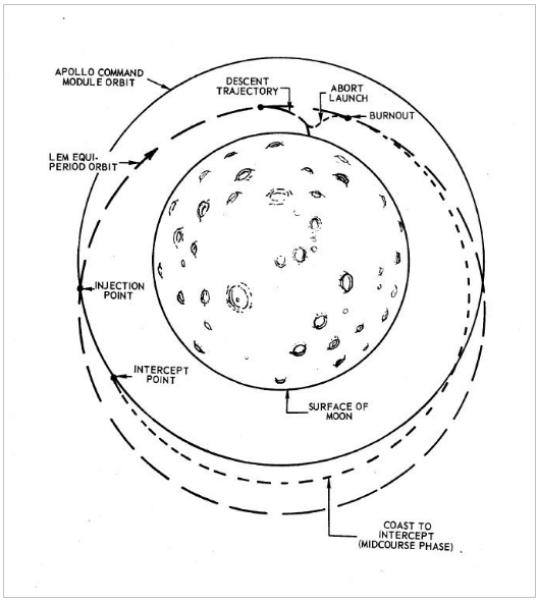
Image: Abort from descent.
On Apollo 13 a nominal translunar abort could not be done because the Service Module Motor was gone. The primary computer in the LM was used, though the procedure had to be created on the spot. Apollo 13 was flying the first non-free-return trajectory of the Apollo missions, so Lunar Orbit Insertion became Trans Earth Injection, so to speak. Once the LM Descent Engine was fired to put the LM on a trajectory that made an Earth re-entry, the AGS was used for most of the return to Earth, which included two mid-course burns to correct the trajectory. This was necessary because the Primary Guidance and Navigation System used too much water — it used gyros that needed cooling — and the LM’s supply of water was tight.
Here is as an obscure fact: A Descent Propulsion System firing with the LM docked to the Command Service Module was first performed in low Earth orbit during the Apollo 9 mission (March 1969) to test the Descent Propulsion System backup capability for the Service Propulsion System. (Apollo 9 was an Earth orbit mission, and with Apollo 7 the most forgotten of the Apollo flights.)
The AGS was a pioneer in that it was the first “strapped-down” guidance system. The system used sensors fixed to the LEM to determine motion, rather than a stable platform as in conventional inertial guidance systems. The entire system occupied only 3 cubic feet and consisted of three major components: (a) an Abort Electronic Assembly (AEA), which was the computer; (b) an Abort Sensor Assembly (ASA), which was the inertial sensor; and (c) a Data Entry and Display Assembly (DEDA), which was a simple version of the data entry keyboard on the primary system. (There is a nice compact technical description of the AGS in Wikipedia: https://en.wikipedia.org/wiki/Apollo_Abort_Guidance_System).
Buzz Aldrin got a doctorate from MIT with a thesis about manual orbital rendezvous of two spacecraft. The primary Guidance Navigation Computer did this perfectly and Buzz thought the AGS was almost as good. Buzz did practice a lot of rendezvous without navigation aids or the primary system or the AGS but he never had to do it in a flight, though I think itched to.
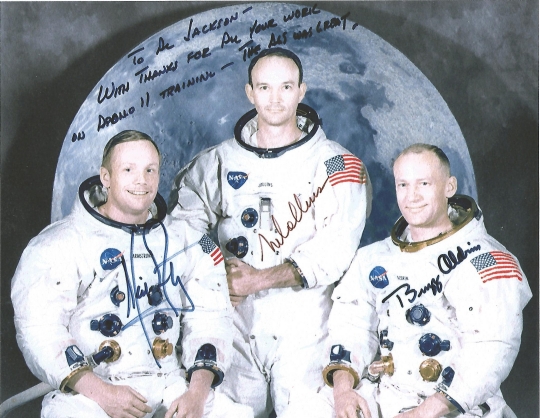
Image: Buzz put a personal message on this photo to me. I did not have much to do with the creation of the Abort Guidance System, AGS, but I was the prime AGS instructor in Houston at the Manned Space Craft Center 1967-1970. The message from Buzz reads: “To Al Jackson — With thanks for all your work on Apollo 11 training — the AGS was great.”
The AGS worked fine. I know of one funny story. When flying with the computers they had to have a ‘coordinate’ system to know where the spacecraft was and where to point it. Apollo had a platform called the Inertial Measurement Unit, designed by MIT, who were the super masters of doing inertial navigation. The IMU could be aligned from the ground or through star-sighting from the Command Module or the Lunar Module.
The AGS could be lined up with this coordinate system by communicating with the primary system. During Apollo 10, the AGS was aligned with the primary. However, after the ‘practice’ descent, ready to rendezvous with the Command Service Module, the Lunar Module had to stage, separating from the descent stage. This was done with the AGS in guidance control. Just prior to separation the LM did a wild spin. A mode switch was in the wrong setting, which led to Gene Cernan’s famous ‘Son of a Bitch’… All the technical details are in the mission report, beginning at 102:45:15 in the document: https://history.nasa.gov/afj/ap10fj/as10-day5-pt20.html.
[[PG: Cernan described the event this way: “I saw the lunar horizon go by about seven or eight times in ten seconds. That’s a hair-raising experience. That’s when I said, ‘Son of bitch, what the hell happened?'” Cernan and Tom Stafford jettisoned the LM’s Descent Stage and were quickly able to regain control, guiding the craft to rendezvous with the Command Module.]]
Another funny instance involves Bill Tindall. Howard Wilson Tindall, Jr. (February 20, 1925 – November 20, 1995) was an American aerospace engineer, NASA engineer and manager. He was an early expert in orbital mechanics and coordinated mission techniques during the Apollo program. In the words of flight director Gene Kranz, Tindall “was pretty much the architect for all of the techniques that we used to go down to the surface of the Moon.”
Bill was a sharp and amusing guy. Here is a note of his referring to how small the memory in the AGS was. In the memo, CSI refers to Co-elliptic Sequence Initiation, and CDH is Constant Delta Altitude, while a ‘G’ mission is a lunar landing and rendezvous mission. MPAD stands for Mission Planning and Analysis Division. Because the image may be hard to read online, I’ll also supply the main text, slightly truncated, after it.

From: PA/Chief, Apollo Data Priority Coordination
Subject: CSI and CDH back into the AGS – maybe
Apparently the TRW AGS people have done a good job of putting the new rendezvous radar navigation filter into that dinky computer. In fact, they now estimate a surplus of some 80 words.
One of our brilliant young engineers here in MPAD — Ed Lineberry — has developed a simple technique for computing the CSI and CDH rendezvous maneuvers provided the CSM orbit is near circular as it should be on the G mission… In fact, he expects that it could be fit into the aforementioned 80 words. He and Milt Contella have already discussed this with the TRW people who are looking it all over. If things go well, he expects they will come to the Software Configuration Control Board with the proposal to include it in some future AGS program and we can decide at that time if that is the best way to use our little 80 word Christmas present.
I wrote this because that idiot Ed Lineberry is too darn modest to tell anybody and I thought you might find it interesting.
I remember when Pete Conrad and Alan Bean were in the Lunar Module Simulator cockpit talking about a failure of the primary guidance just before ascent, but the AGS was working. Then the ascent engine would not fire. One could access the ascent engine within the LM cockpit. Conrad said “I am gonna make sure we bring a screwdriver. We will take the ‘lid’ off the engine and hot wire it!”
The Abort Guidance System was tested on Apollo 9 and Apollo 10 (10 with the wrong mode switch settings). However, it was running in the background on all Apollo missions that used the LM. So Buzz is right about it working well.
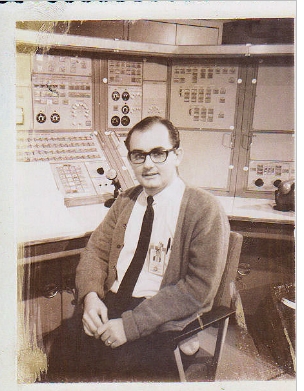
Here is a picture of me at the Lunar Module Simulator Instructors Console, AGS side, taken by a CBS crew for Cronkite’s 20th Century in 1970. The back of my head appeared for about 3 seconds on TV. 3 seconds! (Walter Cronkite did not travel with that film unit.)
And here is the LMS cockpit (crew cabin). Panel 6 is where the AGS keyboard and display are. Click to enlarge the image.
Many Apollo documents are at the following site, though I don’t think all MSC internal documents are there. https://www.ibiblio.org/apollo/Documents/

How Americans See Space Exploration
These are unusual times for a site that usually begins its investigations no closer than the outer Solar System (asteroids are an exception). But there is no way to ignore the Apollo 11 anniversary, nor would I even consider it. Tomorrow I’ll have further reminiscences from Al Jackson, who was on the scene in Houston when Apollo touched the Moon, and on Friday a piece from Neil McAleer with substantial portions of a speech Neil Armstrong gave in Australia in 2011.
For today, a look at how the public views space exploration in our era and earlier, with the surprising result that there seems to be more interest in space than I had assumed. In fact, while it has often seemed as if interest peaked with the moon landings and then slackened, turning instead to space programs of the imagination via high-budget films, there is new evidence that the work we track on Centauri Dreams has a good deal of support.
According to a recent survey, over 70 percent of Americans liken the exploration of space to the European voyages that opened up the western hemisphere and established outposts and trade routes throughout Asia and the Pacific. That’s a higher number than I would have expected, one that reflects, in the words of Jon Miller, director of the International Center for the Advancement of Scientific Literacy at the University of Michigan’s Institute for Social Research, “…the deep-seated impact of the first moon landing in American culture.”
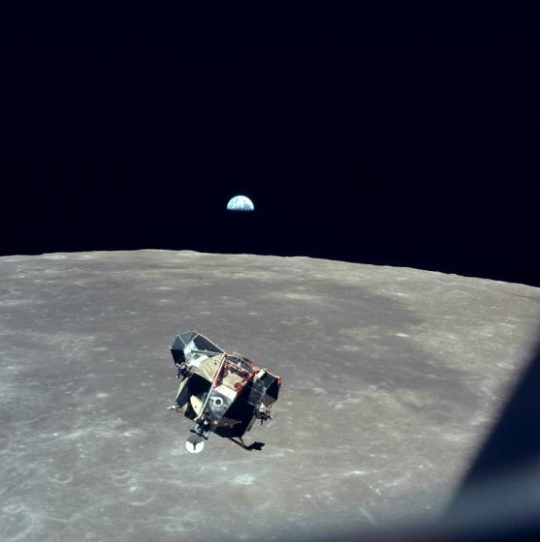
Image: Taken by Michael Collins, this photo shows the lunar excursion module, the Moon, and the Earth from Columbia, the command module, as Armstrong and Aldrin return from the lunar surface. Credit: NASA.
So is this a simple nod to a cherished memory? After all, those who were alive in those days will never forget the experience, a global one, of leading their daily lives with one eye always on the three astronauts on their way to the Moon. Maybe there’s more to it than that, given that the percentage of adult Americans who were alive on July 20, 1969, is only 45%. There does seem to be some movement in peoples’ perception of space exploration, one that this survey tracks.
We’re dealing with the Michigan Scientific Literacy Study, compiled in 2018, with data collected by AmeriSpeak, which is a service of the National Opinion Research Center at the University of Chicago. The survey was taken in November and December of last year and included both online and telephone interviews with 2,312 adults age 18 and older. I have no expertise whatsoever in such surveys, and so cannot judge this one’s accuracy. But let me quote it:
A national survey conducted in 1988 found that 67% of American adults agreed that we should think of space exploration in terms similar to the early explorers of this planet. Thirty years later, a 2018 national survey found that 72% of American adults agreed with the same statement. This level of continuing general support for space exploration indicates that most Americans see the last six decades as a period of positive achievement and that they are supportive of continued efforts to explore space.
Again, I’m surprised. Maybe I’ve been too pessimistic. The study from thirty years earlier refers to the work of the Public Opinion Laboratory at Northern Illinois University, which sampled 2,041 adults by telephone on the same topics. This one was published in the National Science Board’s Science and Engineering Indicators for 1988. The current survey repeated a question from 1988’s survey, asking for agreement or disagreement on this statement: “The space program has paid for itself through the creation of new technologies and scientific discoveries.”
Here again the numbers were something of a surprise, at least to me. Thirty years ago, 56 percent of adults agreed with the statement. In 2018, that percentage had risen to 69%. That’s a fairly robust figure, and it removes the perceived benefits of the space program from the experience of having watched the Apollo missions themselves. Says Miller: “This pattern reflects a long-standing public belief in the indirect benefit of the space program apart from spectacular events like the lunar landing.”
The question I mentioned in the first paragraph on the exploratory impulse asked respondents to agree or disagree with the statement “The United States should seek to explore space in the same spirit that led Europeans to explore this planet in earlier centuries.” 1988’s figure was 69 percent, roughly the same as the 72% tagged in the 2018 results. Interestingly, older adults were more supportive of this view in 2018 than they were in the earlier survey, while men were more supportive than women, though with a difference that has narrowed over the years.
You can see the results of the 2018 survey here. Another excerpt:
This brief examination of national survey data from 1988 and 2018 indicates that American adults tend to recall the first Apollo lunar landing as a landmark achievement of the space program, citing it more often than any other activity as the best achievement of the space program. Parallel national survey data indicate that a majority of American adults think that the space program has paid for itself through the development of new technologies and new scientific discoveries. The proportion of American adults holding this belief has increased steadily over the last 30 years.
Here’s the survey’s Table 2, labeled “Public agreement with statement concerning the value of new technologies from the space program, 1988-2018.”
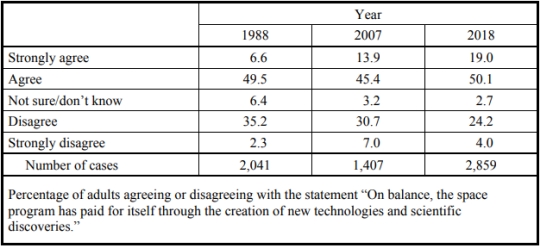
What to make of all this? It’s heartening to see the rise, a steady one, in the proportion of adults who believe the space program has been worthwhile in producing new technologies and generating scientific data. This recognition of the program’s value and the substantial majority of Americans who see space exploration as similar to earlier periods of exploration shows that there is public support for future missions. At the same time, note this: One in five adult Americans were unable to recall any achievements of the space program.
Let’s go with the other 4/5ths. It’s no surprise that, for them, the landing of Apollo 11 on the Moon ranks as the most important result of the space program in its first 60 years, and the media attention to Apollo accompanying the anniversary reinforces that perception. But even as more than 70 percent of Americans want to see space exploration continue, there is no information within this work that shows us how to translate this interest into larger budgets for space.
Remember that Apollo at one point was absorbing 4.4 percent of the federal budget. According to a recent analysis by The Planetary Society (reported in this CBS news analysis), that is the equivalent of spending NASA’s current annual budget on a single project and sustaining the effort for over a decade, some $288.1 billion in inflation-adjusted dollars. This at a time, at least in the earlier ’60s, when rather than today’s gigantic deficits, the United States had a budgetary surplus and increased spending as a way to stimulate the economy was much in the air.
So while a new Gallup poll backs the University of Michigan study that most Americans support space exploration, the kind of big-ticket effort that Apollo represented is ruled out by financial realities. Even so, exciting exoplanet discoveries and spectacular one-off missions like New Horizons are holding the public’s interest, and there is a sense that space delivers tangible results in everyday life as well as scientific return. As we celebrate Apollo 11, then, we can remember how unique the entire Apollo effort was while recognizing that there is still support for creative missions that expand the human spirit while operating on a much slimmer budget.
It would be fascinating to see similar polling on space in Europe and Asia. If anyone has any leads on such, please let me know.

On Apollo, Hayabusa2 & Persistence

Remembering how I felt 50 years ago when Apollo 11 launched, I fully understand those whose sense of let-down at the abrupt end of the moon landings has never gone away. And yes, I was one of those who assumed we would be on Mars by 1990 or earlier, with missions to the Jovian moons gearing up about now. Events in the interim have proven these expectations unrealistic, but last night as I was reminiscing I also thought about what we had done in those 50 years.
50 years ago, for example, the idea of Europa as an ocean world was still a few years out, only entering into serious speculation after Voyager 1 showed us what Jupiter’s immense tidal forces, aided by the gravitational effects of Europa and Ganymede, could do to Io. That flyby was in March of 1979, and if Io’s volcanoes told a tale, they also implicated Europa’s abundant ice. The Galileo mission, despite its problems, then showed us a Europan surface wracked by movement, with ‘chaos’ features, raft-like ice blocks evidently once afloat, frozen into a geologically young terrain. Europa was becoming very interesting indeed.
In 1969 we knew none of this, nor did we have much of an idea what was beneath Titan’s clouds, not to mention what was being flung into space out of bright, frozen Enceladus’ south pole. We hadn’t seen Pluto and its big moon Charon, or viewed a Kuiper Belt Object up close. We were a few years away from Viking (and those landings are another special memory), Mars rovers were only a hope for the future, and no comet had ever been explored.
Exoplanets? Forget it. Who dreamed we had the ability to find them?
The list could go on, but there is no need to recount every robotic mission discovery. While astronauts remained in low Earth orbit, we did indeed perform the initial reconnaissance of the Solar System, and if a mission like Cassini or Kepler doesn’t hold you spellbound, nothing will. You can see that I’m trying to cheer myself up as I look at those unfulfilled expectations of July 16, 1969, but I do think it’s sensible to take stock and appreciate what robotic instrumentation can do amidst the revolution in digital technologies that have transformed our world.
Operations on an Asteroid
So we keep doing what we can with the resources that have been allocated, knowing how much more could be done. Today we look at an asteroid. What follows is imagery from Japan’s Hayabusa 2 mission, which touched down just a few days ago on the asteroid Ryugu, a second landing after the one performed in February. Here we’re seeing views from the spacecraft’s small monitor camera (CAM-H), which operated throughout touchdown, with a field of view looking downwards toward the sampler horn. I’ll just run these in sequence.
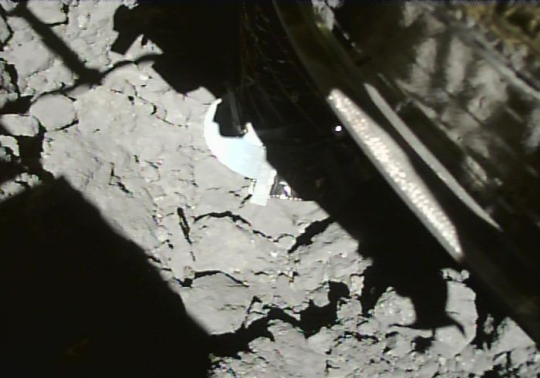
Image: Taken 4 seconds before touchdown with CAM-H (Credit: JAXA).
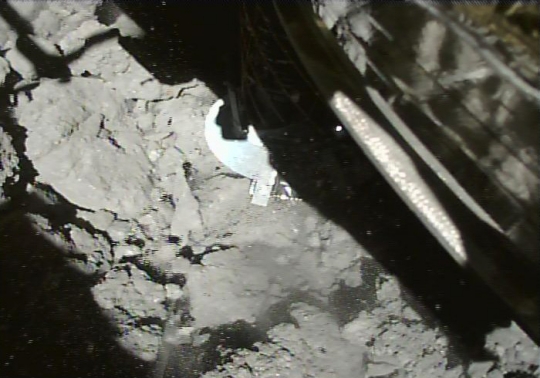
Image: The moment of touchdown captured with CAM-H?Credit?JAXA).
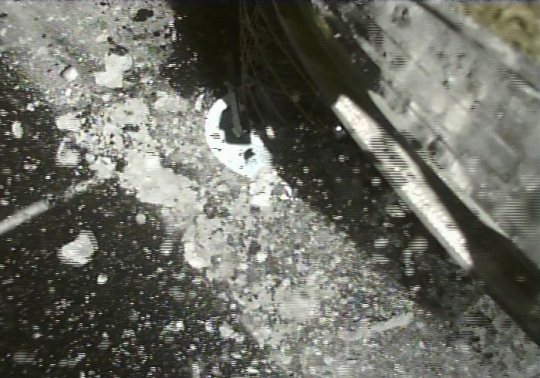
Image: Taken 4 seconds after touchdown with CAM-H (Credit: JAXA).
Nice work indeed, and congratulations to the team that pulled it off. Following events on Twitter at https://twitter.com/haya2e_jaxa was a great way to track the landing minute by minute. The point here is to do a sample return, and you’ll recall that previous Hayabusa2 operations have included the use of a projectile to create a crater whose exposed material could then be sampled before the craft once again ascended. Time on the surface was brief, with Hayabusa2 swiftly returning to a safe position near the asteroid. The departure for Earth is now contemplated for some time late in the year. Have a look at this mission calendar to get a sense of how much has been done, and to keep up with changes to the schedule going forward.
[PPTD] Thank you for your support from all over the world! Everyone in the control room is making a cheerful V-sign for the second touchdown! pic.twitter.com/YUz7sVmQPb
— HAYABUSA2@JAXA (@haya2e_jaxa) July 11, 2019
We also have OSIRIS-REx at asteroid Bennu, another carbon-rich asteroid from which we will be returning samples, though the Bennu material won’t be delivered until 2023. The comparison between samples of the two asteroids should be productive indeed as we add to the first Hayabusa’s asteroid particles from 25143 Itokawa and delve into the composition of C-type asteroids (Itokawa is an S-type asteroid, the second most common after C-type objects).
What We Cannot Know
This paragraph from an editorial about Hayabusa2 in The Japan Times is a reminder of how much the space exploration effort has changed since the Apollo days, especially in terms of commercial activity:
Another important shift is taking place in thinking about space exploration: The private sector is moving into the lead. In the U.S., companies like SpaceX and Blue Origin are setting the pace. Japan has Ispace, which is developing robotic spacecraft technologies to discover, map and use the natural resources on the moon. More than 300 private companies collaborated to create Hayabusa2. Japan must ensure the probe returns safely, and then encourage cooperation among the public and private sectors so there are more successes in the future.
The explosive growth of computer and network resources in the past 50 years occurred in ways unforeseen by science fiction authors, who proved to be more prescient when it came to space exploration being influenced by private individuals and corporations. So as I ponder this point, I have to wonder what developments unknown to us now will shape the future of human and robotic spaceflight in the next 50 years. Miniaturized payloads and artificial intelligence are clearly in the mix, but is it possible to predict any more accurately now than it was then?
I remain an optimist. We keep slogging ahead despite frustrations with the overall pace, celebrating the missions that fly and planning their successors. Nothing affirms a life as much as persistent effort toward a seemingly impossible goal. “Knowing is not enough; we must apply,” said Goethe. “Willing is not enough; we must do.” 50 years after Apollo, keep working.

Sorting Out Circumplanetary Disks
Some confusion has arisen about a possible circumplanetary disk in the system PDS 70, which I wrote about recently (see Exoplanet Moons in Formation?, from June 7). A team led by led by Valentin Christiaens at Monash (Australia) presented evidence for the kind of disk that may have formed the moons of Jupiter around the forming planet PDS 70b, using data from the Very Large Telescope, finding evidence for both the disk and a developing atmosphere here.
The finding was admittedly tentative, which should be kept in mind as we resolve the discrepancy between this and a separate observation, what Rice University is calling in a news release ‘the first observations of a circumplanetary disk of gas and dust…’ What we have in the Rice document is a report on a paper from the university’s Andrea Isella and colleagues, who studied millimeter wave radio signals from the Atacama Large Millimeter/submillimeter Array (ALMA) to identify a circumplanetary disk around the other forming planet here, PDS 70 c.
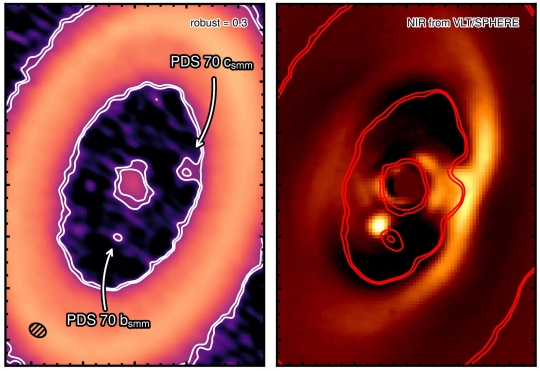
Image: Radio astronomers using the Atacama Large Millimeter/submillimeter Array of telescopes in Chile have found a disk of gas and dust (left) around exoplanet PDS 70 c, a still-forming gas giant that was obscured from view in the 2018 infrared image (right) that first revealed its sister planet, PDS 70 b. Credit: A. Isella, ALMA (ESO/NAOJ/NRAO).
I want to clear this up because several emails express confusion about which planet is doing what. What’s happening is that two separate teams are reporting on findings that deepen our interest in this young system. Circumplanetary disks are new terrain for exoplanetology, and most models of planet formation show that such disks last no more than 10 million years. Thus observing what may be two instances of moons forming around planets in the same system is an extraordinary opportunity. No wonder multiple teams are digging into it.
On the PDS 70b possibility, Isella reports the detection of a continuum emission “close, but not coincident, to the position of PDS 70 b.” His team has two sources of emission that are interesting, one near each forming world, and labels them PDS 70 csmm and PDS 70 bsmm respectively, the ‘smm’ standing for ‘submillimeter.’
In Isella’s work, the millimeter wavelength observations of this star from ALMA were backed by data from the VLT’s SPHERE instrument, and a second VLT instrument called MUSE, which observed in the visible wavelength called H-alpha, an emission that occurs when infalling hydrogen is ionized. “It’s complementary to the optical data,” said Isella, “and provides completely independent confirmation that there is something there,”
What Isella is arguing is that the two sources, one near each planet, might have different physical origins, with the source at PDS 70b offset from the planet itself. Here’s what the Isella paper, which appears in Astrophysical Journal Letters, says about PDS 70b:
The last item of discussion concerns the nature of PDS 70 bsmm. Its proximity to PDS 70 b suggests that the observed continuum emission might be somehow related to the planet. Due to the uncertainties on the position of the host star in the ALMA images, we cannot exclude that the sub-millimeter continuum arises for circumplanetary dust.
And here is a color-enhanced image of millimeter-wave radio signals showing the disk of gas and dust around PDS 70c:
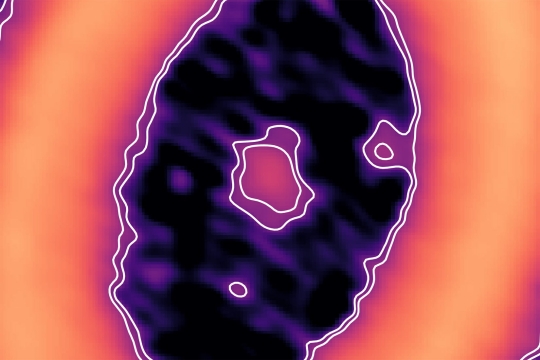
Image credit: A. Isella, ALMA (ESO/NAOJ/NRAO).
Between the two papers, then, we’re looking at the possibility of two circumplanetary disks forming around separate worlds in this system. Both these planets appear to be 5 to 10 times larger than Jupiter, with the innermost at roughly the distance from Uranus to the Sun, while PDS 70c is in an orbit analogous to Neptune’s. It’s clear that this system is going to repay further study, for we are now at the point where our observatories can examine planetary systems in rich detail and observe moon formation in its nascent stages. Says Isella:
“There are a handful of candidate planets that have been detected in disks, but this is a very new field, and they are all still debated. (PDS 70 b and PDS 70 c) are among the most robust because there have been independent observations with different instruments and techniques.”
The Isella paper is “Detection of continuum submillimeter emission associated with candidate protoplanets,” Astrophysical Journal Letters Vol. 879, No. 2 (abstract / preprint). The Christiaens paper is “Evidence for a Circumplanetary Disk around Protoplanet PDS 70 b,” Astrophysical Journal Letters Vol. 877, No. 2 (3 June 2019). Abstract / Preprint.

